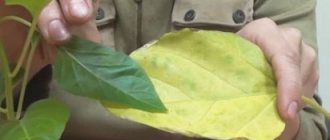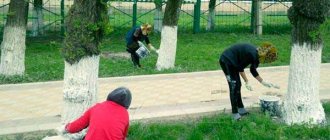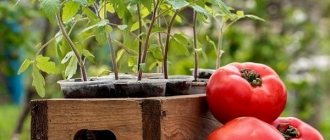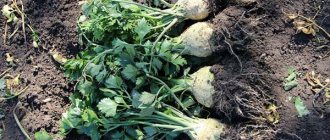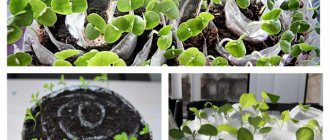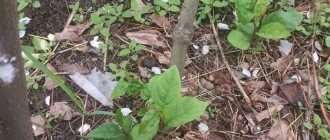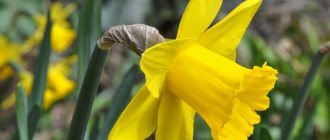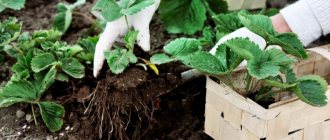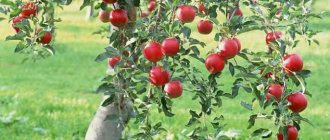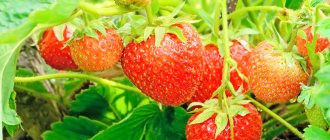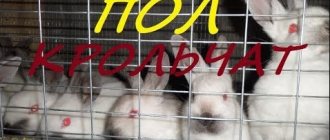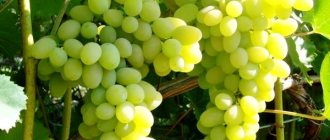Are there any benefits to picking and what are its harms?
Gardeners have different opinions about this procedure; there are supporters and opponents. Some believe that picking is necessary for the successful growth and development of plants, while others are confident that seedlings will grow well without additional human intervention.
But the following advantages of the process are still generally recognized:
- There is no need to thin out the sprouts in the future. Thanks to picking, all weak and underdeveloped seedlings are eliminated at an early stage. As a result, only strong plants remain, which are further grown to adulthood.
- Transplanted crops better tolerate further transplantation to a permanent location. Their root system easily adapts to a new environment.
- Picked seedlings after transplanting into open ground do not get sick, are highly resistant to external environmental conditions and diseases, and their productivity also increases.
- Plants do not stretch or overgrow. After picking, active formation of the root system begins, and the growth of the above-ground part slows down. Therefore, when the stems are stretched excessively, it is recommended to dive.
But the procedure also has disadvantages. The first is that the main root, which is pinched, loses the ability to grow to great depths and extract water from there. This is a minus, especially in hot times. But the problem can be solved by regular and abundant watering.
The second negative point is that there is a risk of seedling death. Although it is very low, it is still there. After all, replanting is always stressful for plants.
What crops can be picked
Some crops tolerate root cropping well - the root system grows and a powerful stem is formed. This category includes tomato, leek, rosemary. Flowers can also undergo a similar “operation” - petunia, ageratum, alyssum, viola, and lobelia tolerate the procedure well. Why crop flowers? The goal is the same as in the case of vegetables - stimulation of the root system is intended to strengthen the plant.
Related article:
What to do if tomato seedlings stretch out
Which crops require picking and which do not?
Not all plants need picking. The fact is that cultures have different root systems. For example, if a seedling has a very delicate root, it may simply not withstand such interference, and as a result the seedling will die.
There is definitely no need to pick crops such as:
- cucumber;
- melon;
- pumpkin;
- zucchini;
- watermelon.
When 3-4 leaves appear, they are successfully transplanted to a permanent place. Or they are sown immediately in open ground.
Those who grow tomatoes, eggplants, peppers, lobelia and petunia cannot do without picking.
What seedlings should be picked?
When we talk about classic picking with pinching the central root, it is worth remembering that this procedure has a beneficial effect on seedlings of such crops:
- tomatoes (in the phase of 2-3 true leaves),
- carnation,
- cabbage,
- garden strawberries,
- petunia,
- lobelia.
But eggplants and peppers are controversial crops. They are sensitive to root damage and often get very sick after transplanting, but they react positively to transshipment. So either grow them immediately in separate containers, or replant them together with a lump of earth.
When should you dive?
Transplantation with root pinching is carried out approximately 3 weeks after the sprouts appear. During this period, the plants should grow 3-4 full leaves. It is not recommended to touch them before, but you should not be late with picking.
Transplantation is carried out not only specifically to improve crop growth, but in the following cases:
- seedlings grow too densely, which prevents them from developing normally;
- the sprouts began to hurt and die, so it is urgent to save healthy seedlings;
- The growth of seedlings is excessively rapid; they reach their height prematurely.
The procedure is usually performed once, but sometimes there is a need to repeat it, for example, if there is not enough space for the roots, the stems are strongly stretched upward
What to do to prevent seedlings from stretching.
As you know, due to lack of light, seedlings begin to stretch out and weaken. What often happens when growing seedlings on an apartment window sill. And in greenhouses, for one reason or another, similar incidents happen.
In such cases, it is necessary to use growth regulators on the seedlings, such as the Atlet stimulant or its analog Krepen. These drugs help the seedlings survive the dive. In addition, it prevents the above-ground part of the plant from outgrowing and overtaking the root system in development.
Seedlings can be treated with these preparations either by the root method by watering the soil, or by the foliar method by spraying the above-ground part of the plant.
As soon as the active substance enters the plant cells, it causes a slowdown in growth. Which leads to the redistribution of nutrients entering through the root system.
As a result, after treatment, the plants’ stems become thicker, the leaves increase in size and, most importantly, the root system begins to develop intensively. A good root system means a strong and well-balanced plant.
Methods for picking plants
There are 3 methods for picking seedlings:
- Pike. You can use a small stick as a pike. With its help, they loosen the soil around the plant and pick up the root without causing severe damage. Before the procedure, it is important to water the soil well. For small seedlings, this technique is simply irreplaceable.
- Finger method. Similar to the first method, but instead of a pike, your own fingers are used. With their help, bushes are removed, and then a hole is made in the new soil, where they are then replanted. It is most convenient to pick large seedlings with your fingers.
- Plank. For this procedure, you will need a thin small board, with which you can remove several plants at once. Thanks to this technique, several crops can be transferred at once. But the quality of such picking is worse than in previous cases.
For transplantation you will need to prepare equipment. You will need water, large containers, soil mixture and a device with which to remove seedlings.
Preparing soil and containers
The soil for seedlings needs to be saturated with useful substances. During the picking process, plants experience stress, they have to adapt to a new place, so nutrition is very important for them.
Gardeners advise purchasing ready-made soil in the store. It contains all the necessary elements, and there are definitely no pathogenic microorganisms and weed seeds. You can take soil from your own plot, enriching it with mineral or organic fertilizers.
You can use different containers for picking depending on your taste. You can buy them in specialized stores or adapt something at hand.
For example, many people prefer to plant seedlings in plastic cups, having previously made several holes in the bottom to allow excess moisture to escape.
Gardeners also love peat pots because they can then be planted directly together with seedlings in open ground.
You don’t have to pull out the plants, which greatly simplifies the task and prevents damage to the root system.
The difference between picking and transplanting
Picking seedlings is a transplantation of a seedling, during which the tip of its root is pinched to about a third of its length. This procedure is necessary for the formation of a powerful root system - when growth in length is limited, lateral (additional) branches are formed in large numbers on the main root, which improves the quality of nutrition and strengthens the plant in the soil.
Related article:
Seedlings are growing by leaps and bounds: 6 effective stimulants for home use
Many gardeners call ordinary transplanting of seedlings “picking”. This is incorrect because not only the process itself is different, but also its result. Picking is precisely pinching off the tip of the root when planting; other procedures do not fall under this definition.
“Resettlement” of seedlings without picking (shortening the main root) is carried out in 2 ways:
- transshipment with a lump of earth;
- transplantation (without preserving the coma).
When transferred to larger pots, the main root is not shortened, and there is no incentive to increase the area of the root system. The advantage is minimal trauma - a lump of earth prevents damage, seedlings quickly grow, while after cutting off the main root by a third of its length, the plants need some time to adapt.
If young seedlings are planted without preserving a clod of soil, then it is important not to miss the deadline. When sowing densely, the roots intertwine with neighboring ones and the more time passes, the more difficult it is to separate the plants from each other. During the separation process, not only the central parts of the root are damaged, but also the lateral branches, which, unlike deliberate pinching, only causes harm.
Important to know: When to sow seeds for seedlings
Picking instructions
The transplant procedure consists of several successive stages. You need to do the following:
- Water the crop. This is a mandatory condition regardless of which method you plan to use for picking.
- Determine the planting depth so that the plant is not cramped and the root system can expand freely in the new recess.
- Remove the bush from the pot. This is the most crucial moment, because there is a risk of damaging the roots. Carefully loosen the soil located near the crop, trying not to touch the root system, and remove it.
- Pinch the spine by 1/3.
- Transplant the plant into a new container with a larger size, carefully straightening the roots, and fill the hole with soil.
Depending on the specific crop, the picking process may vary slightly.
For example, sometimes it is necessary to pour water into the hole before transplanting or water the seedlings after the procedure.
How to pick seedlings correctly
There are two ways to plant seedlings:
Picking by transplantation method
In this case, two hours before picking, the seedlings must be well watered with warm water to facilitate the process of separating the plants. Large pots, boxes or glasses are filled three-quarters full with the prepared soil mixture, slightly compacting it. Use your finger to make a hole in the soil so that the entire length of the root of the transplanted seedling fits into it.
The plant is carefully pulled out of the small box or pot along with a piece of earth. This can be done with a teaspoon, using a sushi stick or a pencil, a match or a toothpick. It is best to hold the plant by the earthen ball or by the cotyledon leaves, but not by the stem.
Afterwards, the roots of the seedling are freed from excess soil.
If desired, you can pinch the main long root of the plant to stimulate the regrowth of lateral roots. Then the seedling is placed in the hole and covered with earth. The soil around the seedling is slightly pressed down with your fingers. Tomato seedlings can be buried in the soil almost to the cotyledon leaves; seedlings of peppers and eggplants must be planted at the same depth at which they grew in small containers. And after picking, the seedlings are watered. If the seedlings are very small (petunias or celery), the pots are placed in a pan of water and the plants are sprayed. After picking, containers with seedlings are placed away from bright light for a couple of days.
Picking by transshipment method
We recommend this option because the roots of the picked plants are not injured, the seedlings do not need time to adapt and their growth does not slow down.
With this method of picking, a couple of days before the process, you need to stop watering the seedlings so that the earthen lump calmly comes out of the cup. Large containers are filled one third with earthen substrate.
We turn small cups with seedlings upside down, passing the above-ground parts of the plants between our fingers. Lightly press onto the bottom of the glass and carefully remove it - the plant, along with a lump of earth, remains in the hand.
Next, each seedling, along with a lump of earth, is placed in a large pot.
The voids are filled with soil. Then water abundantly and keep in the shade for one or two days.
Transshipment does not disrupt the structure of the root system and can be used even for such capricious crops as peppers or eggplants.
Caring for seedlings after picking
If anyone thinks that after transplanting they can put the seedlings on the windowsill and only water them periodically, they are deeply mistaken. After picking, plants need careful care. After all, the following measures still need to be taken:
- organize optimal lighting;
- water;
- apply fertilizers;
- ensure that crops are not exposed to pests and diseases.
Harden off seedlings
If necessary, re-picking may be necessary in the future.
What is seedling picking?
This term comes from the French word piquet , meaning “ stake , peg ”. As a rule, it refers to the transplantation of young plants (seedlings) from a common container into separate pots. Sometimes picking is also called pinching the tap root during transplantation - this is done to force the root system to branch.
Picking is a traumatic procedure for plants
Thus, the reason for doubt becomes clear from the definition: picking is a traumatic procedure, interference in the processes of growth and development of seedlings. Of course, this raises numerous questions to which we will try to find an answer.
